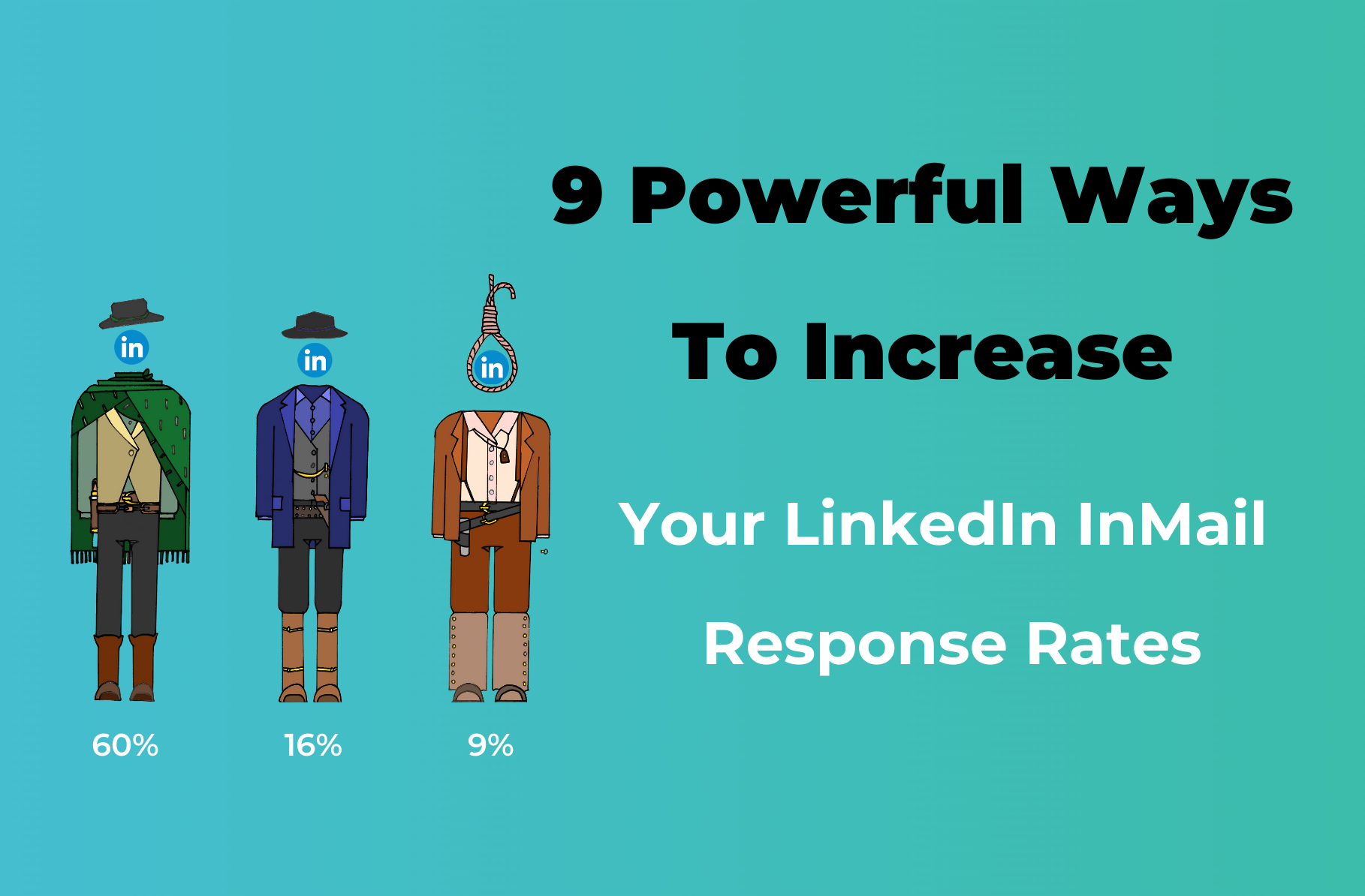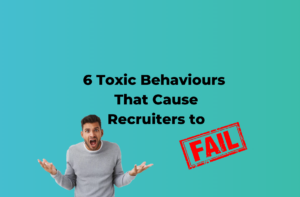9 Powerful Ways To Increase Your LinkedIn InMail
Response Rates
If you’d like to treble or quadruple your InMail response rates, it’s crucial to think more carefully before you press the ‘send’ button.
In this article, I’ll be sharing 9 simple tips to improve your InMail response rates.
1. What is the Goal of Your InMail?
Did you know that the average response rate for InMail across LinkedIn is 16% whilst some recruiters are achieving as much as 60% or more?
So, are you measuring your InMail response rates?
Let’s take a look at why the NUMBER ONE goal of your InMail has to be one thing…
To get a response from your candidate!
Why is this so important?
Well, if you get a response from a candidate, you can reuse the InMail because you get the ‘message’ credit back from it.
That’s one good reason why it is critical not to be too ‘salesy’ in your message.
You want the person to reply.
Later in this article, I’ll discuss how to write an InMail in a compelling way.
But now, your number one goal has to be to get a response from your target candidate—BECAUSE YOU CAN RE-USE THE INMAIL CREDIT.
Think about the importance of this:
Recruiter A sends 100 InMails with a 16% response rate—i.e. 16 responses.
Recruiter B sends 100 InMails and gets a 60% response rate, meaning he gets 60 responses.
So, Recruiter A now has only 16 more InMails to send because he WASTED 84 InMails.
Recruiter B has 60 InMails to reuse.
Assuming the same percentage InMail response rate, then out of the 60 remaining InMails, 36 responses should come back.
If Recruiter B still receives the same percentage of responses, he will be able to use these credits for the next 36 InMails and receive another 21 InMail credits, and so on.
Look how many more candidates Recruiter B can approach!!!
Therefore, receiving a response from your InMail to a target candidate has to be your number one goal.
2. Make Your Subject Line Stand Out From the Crowd
Did you know that some 5 billion people globally send and receive electronic messages every day?
People are bombarded with messages from WhatsApp, Messenger, Instagram, Snapchat, email, and LinkedIn.
Now think about your own attention span—or the attention span of your staff.
When you receive an InMail, do you look at the subject line first before deciding whether to read on or delete it?
So why do so many recruiters not think more carefully about the subject line of their InMails? It’s probably the most important part of your first message.
Remember, people get bombarded by messages—they may be walking down the street looking at their mobile phone and their attention span is likely to be brief. That’s why you’ve got to think creatively about how to hook their attention via your subject line.
Keep your subject line short and sweet—around 7-8 words and make it easy for them to digest.
Think outside the box—don’t just copy what everyone else is doing. Ask yourself how you can stand out and connect with the person you’re reaching out to.
Spend a little more time creating the best InMail subject line, and you’ll definitely be able to source more suitable candidates as a result.
3. Don’t Make a Crass Introduction
Imagine you are on the platform of a train station waiting for your train to arrive. You wouldn’t walk up to the person next to you and say:
“Hello, I am a recruiter, I am recruiting for a full-stack developer role; are you interested?”
So why do so many recruiters send a version of this crass introduction within their InMails???
Tip: Google it!!!
Duh, am I serious? Yes, I am. I’m very good at writing personalized messages, but I still regularly Google things like:
‘The best way to introduce myself via InMail’.
Why do I do this? Because things change, ideas get copied, and candidates receive similar messages—put simply, I want to stay ahead of the curve and be different. I may not copy the example message exactly, but I’ll get ideas from other people. Plus, I get ideas from different parts of the world that may not currently be used within my own country.
4. Keep it Simple and Include at Least One Selling Point
Top candidates receive lots of InMails, so make sure you grab their attention (without being too ‘salesy’).
Think: “Why should a happily employed person leave their current job in order to work for my client?”
Here’s an example of how not to do it…
“I’m John from Ace Talent Recruitment,
I’ve just noticed that you have a wealth of years of experience in the financial sector and have some experience with Oracle, and you might just be the right fit for an Accounting Foundation Cloud Service (AFCS) Business Analyst role that is based in London and is currently available right now.
I’m very impressed with your wide range of experience and skills and want to learn more about you and have a deeper conversation regarding Oracle.
Would you have some time on Wednesday or Thursday for a quick call to talk more about your interests and the details of the role?”
To be fair, it’s not a disastrous message BUT ask yourself this…
If you were a happily employed Business Analyst, why would you want to change jobs for what appears to be just another Business Analyst role?!!
Take a look at the next tip on personalised messages and look at how the first recruiter added a tangible fact about prospects within their client’s role and linked that to something they’d noticed in their target candidate’s profile, whilst the second recruiter highlighted another fact—i.e., that their client is offering a significantly above-market-rate salary with exceptional growth prospects.
NB: Use facts you’ve gleaned from your clients rather than the vague ‘great prospects’ line trotted out by your competitors.
5. Personalise Your Message
Your InMail message should make your candidate feel special. You can ask questions or include things in your InMail that they’ve mentioned in their profile. You will be pleasantly surprised how this brief touch will improve your LinkedIn InMail response rate.
For example, if you’ve seen that the candidate has been promoted twice in the last year, you may use this in your message as follows:
“Hi, John,
I’m reaching out as I noticed that you’ve been promoted twice in the last two years.
One of my clients, a major XYZ company, has doubled in size within the last year and they are looking to hire ambitious people with your background to help them go to the next level.
Are your ambitions being completely fulfilled in your current job or would you be open to having a conversation with me to explore other suitable options?
Please let me know either way—I’d be happy to have a quick call with you tonight if you’re free.
Kind regards,
Shaheed
0980 7677 ****”
As you can see, this recruiter simply extracted a fact from their LinkedIn profile and then used that fact to make the candidate feel special—i.e. not spammed!
Here’s another example of a personalised message.
“Hi, John,
I couldn’t help but notice your article about X on LinkedIn. It was very insightful.
After reading, I had a closer look at your profile, and I noticed that you have an XYZ background. As it happens, one of my clients is looking to recruit an XYZ and they’re offering a significantly above-market-rate salary with exceptional growth prospects.
Can you take a call after work this evening to explore whether this could be your next career move?
Kind regards,
James
0900 77 ****”
The more personal the message, the higher the chances of a response to your InMail, which is exactly what you are looking for.
6. Think Carefully About the Message’s Timing
According to LinkedIn data, InMails sent between 9 am and 10 am on weekdays get the highest response rate. And at the time of writing this article, LinkedIn claims InMails sent on Saturdays are 16% less likely to get a response. As such, choosing the best time to send your InMail is crucial.
Of course, no one knows LinkedIn data analytics better than LinkedIn itself, so if you have a LinkedIn Account Manager, pick their brains to get the most up-to-date advice and then test it.
7. The Assumptive Close
Many recruiters use the closing line in InMails; “Let me know if you’re interested”. Of course, you will get some replies to this, but think about it. If your target candidate is not interested, why should they reply?
Surely you want to get a response today, don’t you? Here are a few alternatives…
“Either way, would you be so kind as to let me know?”
“I noticed that your office is close to Starbucks on ABC Street. I have a meeting there tomorrow evening. Do you fancy joining me for a coffee?”
“Can you take a call after work this evening to explore whether this could be your next career move?”
“By the way, if you are happy to chat, I’ll explain the role in detail to you without any pressure, so that you’re able to make a considered decision.”
8. Treat Your LinkedIn Profile Like a Mirror
When you look into your bathroom mirror in the morning, I assume you try to look your best before leaving home?
Make no mistake, one reason for the lower percentage InMail response rates is that your profile is not very appealing. If your photo is unprofessional, expect a lower response. If the text in your profile does not ooze professionalism, nor convey your expertise, expect a lower response.
I will not write another article here on this single point—I just want you to think and—today — look at your own profile through the eyes of a target candidate and take corrective action.
Why? Because when candidates receive your InMails, some of them will look at your profile first before deciding what to do next. Your profile can either make or break your own success. With a professional headshot picture, eye-catching headline, interesting career summary, visual media, active profile, and so on, you will be pleasantly surprised to receive a greater percentage of InMail responses.
9. Regularly Review Your InMail Percentage Response Rates
When was the last time you checked the percentage response rates of your own InMails?
Or the percentage response rates of your employee’s InMails?
Yesterday, one of my recruiters told me that his response rate is 24%.
Good!!!!!!!!!!!
Err, why is this good bearing in mind I told you at the beginning of this article that some recruiters achieve in excess of a 60% response rate?
The answer is that I now know that his InMail response rate is only 24% and I can help him improve it.
Measurement is crucial to improving response rates and yet, hardly anyone does it. And it’s free via LinkedIn.
So, what are you waiting for?
Summary of the Best Ways to Improve LinkedIn InMail Response Rates:
- What is the goal of your InMail?
- Make your subject line stand out from the crowd
- Don’t make a crass introduction
- Keep it simple and include at least one selling point
- Personalise your message
- Think carefully about the message’s timing
- The Assumptive Close
- Treat your LinkedIn profile like a mirror
- Regularly review your InMail percentage response rates
Final tip: Some years ago, a marketing mentor of mine coined a phrase that stuck with me.
“The Internet doesn’t lie.”
To be fair, this was before the days of ‘fake news’ (!)—but what he meant was as follows:
Your InMail results will tell you the truth about what people thought of your messages. This is your acid test.
So, craft the best subject line and personalised message you can—and then coldly analyse your percentage response rates on a regular basis.
If you do this, success is guaranteed.
www.RecruitmentTraining.com is a leading provider of recruitment training, offering over 700 industry videos that aim to enhance the skills of every recruiter in your business and acquire the best recruitment-specific management techniques. Through a recruitment-specific Learning Management System, you can efficiently manage all learning within your organization while benefiting from unique learning accountability tools that promote the effective implementation of knowledge. To explore further, simply click the ‘Show Me How‘ button below.





